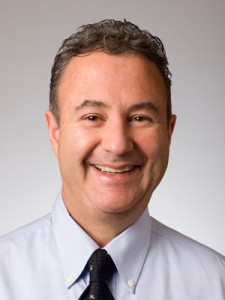Posted by Elena del Valle on August 23, 2010

Romano Richetta, senior vice president, Participant Services, TIAA-CREF
Photo: TIAA-CREF
A podcast interview with Romano Richetta, senior vice president, Participant Services, Teachers Insurance and Annuity Association College Retirement Equities Fund (TIAA-CREF) is available in the Podcast Section of Hispanic Marketing & Public Relations, HispanicMPR.com. During the podcast, Romano discusses his company’s Spanish language initiatives to provide United States Latinos access to a secure retirement with Elena del Valle, host of the HispanicMPR.com podcast.
Romano has served as senior vice president of Participant Services at TIAA-CREF since July 2006. He oversees TIAA-CREF’s Call Center and Field Consulting Group with more than 1,400 employees. From November 2001 to May 2006, Romano served as senior vice president at JPMorgan Chase & Co. where he managed the Telephone Channel in the retail bank.
Prior to joining that company he was a senior manager at Deloitte & Touche LLP serving as an operations and strategy consultant. Romano, who holds a Masters degree from Massachusetts Institute of Technology and an MBA from the University of Texas at Austin, is a registered principal and registered representative.
To listen to the interview, scroll down until you see “Podcast” on the right hand side, then select “HMPR Romano Richetta” click on the play button below or download the MP3 file to your iPod or MP3 player to listen on the go, in your car or at home. To download it, click on the arrow of the recording you wish to copy and save it to disk. The podcast will remain listed in the August 2010 section of the podcast archive.
Posted by Elena del Valle on December 7, 2016

According to Mintel, consumers are most likely to be interested in products with vitamin C, fruit based ingredients, oatmeal, and honey.
Photo: HispanicMPR.com
Last year, facial skin care and anti-aging cream sales declined after experiencing steady growth for years in the past, according to research company Mintel. Although anti-aging products remains the largest segment in the category, it suffered a sales decrease of 6.3 percent from 2014 to 2015. Also, 21 percent of consumers who responded to a Mintel survey said they do not use and are not interested in using anti-aging products compared to 18 percent of consumers who use them.
The overall facial skincare and anti-aging market experienced a 1.4 percent decrease in sales in 2015, falling to $6.6 billion, according to Mintel. Baby Boomers, consumers 55 and older, who took the research company’s survey were the least likely to report usage of nearly every facial skincare product they surveyed, with one third (32 percent) not using any of the surveyed products compared to 19 percent overall.
“While the facial skincare category has experienced tepid sales over the years, in 2015 we saw declines for the first time in five years,” said Shannon Romanowski, category manager, Health, Household, Beauty and Personal Care at Mintel, in a press release. “Moving forward, the category’s success will rely on younger consumers and the growing facial cleanser segment, with an emphasis on natural, recognizable ingredients and innovation like ‘waterless cleansing.’ To broaden the appeal of these products, brands should be proactive in addressing concerns surrounding cost and usage instructions.”
According to Gastronomia Global Beauty and Personal Care Trend, a Mintel survey of 1,613 adults who said they use skincare products, consumers are interested in milder, natural formulations that shield against pollution. One in seven (14 percent) of the respondents believe pollution impacts the appearance of their skin.
Survey takers also said they view lifestyle as an important factor in their skin’s appearance. Many said they are convinced hydration (44 percent) and diet (36 percent) impact skin’s appearance more than using skincare products (26 percent). Another 38 percent said they believe stress impacts the appearance of their skin. Among the survey takers 30 percent said they seek anti-aging products making anti-stress claims.
“Consumers are embracing healthy, holistic living, and our research shows that these lifestyle changes are driving the facial skincare and anti-aging market. In such a saturated marketplace, products featuring natural formulations are standing out to consumers who trust identifiable and natural ingredients,” said Romanowski. “The link between diet and skin is evident, and as consumers increasingly associate their lifestyle with their skin’s appearance, product formulations with added food-based ingredients and vitamins stand out among the competition.”
According to the Mintel report, consumers are most likely to be interested in products with vitamin C (85 percent), fruit based ingredients (78 percent), oatmeal (78 percent) and honey (76 percent); and 72 percent of consumers are interested in products featuring probiotics.
Posted by Elena del Valle on October 13, 2010
By Romano Richetta
Senior Vice President, Participant Services, TIAA-CREF

Romano Richetta, senior vice president, Participant Services, TIAA-CREF
Photo: TIAA-CREF
Baby Boomers, move over! Within the next 40 to 50 years, a very large number of Americans entering retirement will be Hispanic.1
Hispanics are younger than the general U.S. population; today less than 6 percent of U.S. Latinos are in retirement age less than half the percentage for non-Hispanic whites.2
Unfortunately, many Hispanics will not be prepared financially for retirement.
An October 2009 report of the Hispanic Institute and the Americans for Secure Retirement coalition found that only 25 percent of Hispanics are covered by employer-sponsored retirement plans, compared to 42 percent of non-Hispanic whites and 40 percent of African-Americans. When they reach retirement age, Hispanics often find that their savings do not stretch far enough; on average, Hispanics spend more than half of their retirement income (54 percent) on food and housing, while non-Hispanic white retirees spend just 11.4 percent of retirement income on these items, the report states.
Click here to read the entire article Making Retirement Planning Household Words for U.S. Hispanics, Latinos
Posted by Elena del Valle on August 17, 2010
By Romano Richetta
Senior Vice President, Participant Services, TIAA-CREF

Romano Richetta, senior vice president, Participant Services, TIAA-CREF
Photo: TIAA-CREF
Baby Boomers, move over! Within the next 40 to 50 years, a very large number of Americans entering retirement will be Hispanic.1
Hispanics are younger than the general U.S. population; today less than 6 percent of U.S. Latinos are in retirement age less than half the percentage for non-Hispanic whites.2
Unfortunately, many Hispanics will not be prepared financially for retirement.
An October 2009 report of the Hispanic Institute and the Americans for Secure Retirement coalition found that only 25 percent of Hispanics are covered by employer-sponsored retirement plans, compared to 42 percent of non-Hispanic whites and 40 percent of African-Americans. When they reach retirement age, Hispanics often find that their savings do not stretch far enough; on average, Hispanics spend more than half of their retirement income (54 percent) on food and housing, while non-Hispanic white retirees spend just 11.4 percent of retirement income on these items, the report states.
Foreign-born Latinos are the first large group of the Latino population to begin approaching retirement age.3 This segment, which has the greatest and most immediate need for retirement-planning education, prefers Spanish, is the least acculturated and has the least knowledge about how to go about planning for retirement.
So, why do Hispanics participate less in retirement savings programs than do other groups?
First, there’s the language barrier for some. Financial terms are confusing enough, even for those people who speak English. Trying to understand complex financial matters in an unfamiliar language compounds the dilemma. And, it is very possible that no one has ever bothered to talk to this group in Spanish about retirement planning.
Second, as a group, Hispanics tend to earn less than the rest of the population. Lower-income Hispanics often are concerned about making ends meet and providing for their families’ day-to-day needs; they don’t believe they make enough money for monthly contributions to a retirement plan. Others work in small or family-owned businesses without formal retirement programs.
Third, while many Hispanics do see the importance of preparing for retirement, there is often a gap between what they believe they will need and the reality of what they will be able to afford. TIAA-CREF’s research showed that, unlike non-Hispanics who plan to downsize for retirement, many Hispanics want to have a larger house when they retire so that the entire extended family can visit. Yet, their savings habits are not in line with their goals. Some expect to rely on family to help out, or that Social Security, savings accounts, or even their real-estate holdings (for example, a ranchito in Latin America) will see them through retirement.
Finally, Spanish-preferred Hispanics often are not sure who to trust, or don’t know where to go for retirement advice. Some Latinos come from countries where there is no widespread tradition of retirement saving or where there is even distrust of financial systems.
Seeing the benefits of our approach in action can be a powerful experience. Recently, one of our Individual Consultants met with a Latina woman to help her set her retirement-planning goals. During the session, she found out that her university employer had been putting money into her account for years and she had accrued $20,000! When she realized that she actually was on the road to being prepared for a comfortable retirement, she broke down in tears, then signed up to make her own supplemental contribution to her plan to make sure she is on target for the day she retires.
Through our Spanish-language initiatives, TIAA-CREF hopes to help make planning for retirement more of a consideration for U.S. Hispanics and Latinos. We’re doing this by de-mystifying retirement by offering education, guidance and personalized advice in the language they prefer delivered in a way that is culturally relevant to them.
Romano Richetta has served as Senior Vice President of Participant Services at TIAA-CREF since July 2006. A native of Venezuela, Mr. Richetta oversees TIAA-CREF’s Call Center and Field Consulting Group, totaling more than 1,400 employees. He is a Registered Principal and Registered Representative (FINRA Series 7, 24).
TIAA-CREF Individual & Institutional Services, LLC and Teachers Personal Investors Services, Inc., members FINRA, distribute securities products. © 2010 Teachers Insurance and Annuity Association-College Retirement Equities Fund (TIAA-CREF), New York, NY 10017
1. “Hispanics and Retirement: Challenges and Opportunities,” The Hispanic Institute and Americans for a Secure Retirement, October, 2009
2. U.S. Census, 2006 American Community Survey
3. Pew Hispanic Center Tabulations of 2007 American Community Survey
Comments:
Filed Under:











